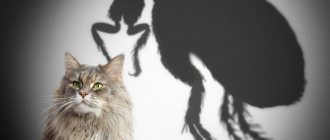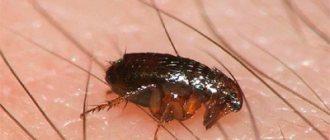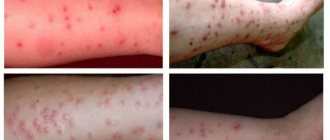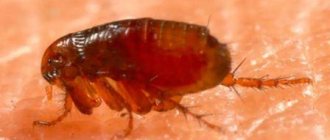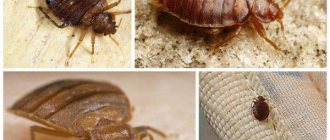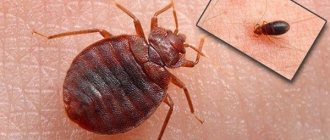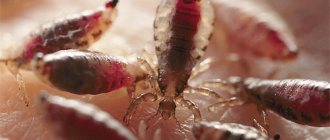How to recognize a flea bite
This is the flea's "greeting"
As a rule, flea bites are located in a continuous path, but not always - there may be chaotically located foci. The bites itch unbearably, sometimes even swell and are characterized by severe pain. But that comes later, and in the process they secrete a special anesthetic secretion. Typically, fleas bite those places where the skin is thinnest - the tops of the feet, heels, ankles and lower legs.
The bite site immediately turns red and begins to itch very much. After a couple of days, the point enlarges and soon becomes a small blister, in the center of which there may be a bloody ulcer. Experts do not recommend scratching the problem area, even with severe itching. The best solution is to relieve pain using special means.
Failed to avoid attack - what to do
Most often, improvised means are used to treat flea bites. As mentioned above, bite sites should not be scratched. First, it is better to wash them with warm running water and antiseptic soap, and then lubricate them with Calamine lotion. But if you don’t have such a remedy in your home medicine cabinet, then you can use alternative homemade medications.
A flea looks like this
- In a glass or mug, dilute sodium bicarbonate with a small amount of water until a paste-like mixture forms. Apply the prepared mixture to the affected area of the body for 20 minutes. This remedy will help to calm the itching and burning a little.
- In a glass container, mix water and apple cider vinegar in a 2:1 ratio. Place in the refrigerator for 10-15 minutes. Dip a thin strip of natural fabric or gauze into the cooled mixture and apply to the bite site for 20 minutes.
- Boil 350 ml of water, add a few lemon skins to it, and boil for 5 minutes. Cool. Next, moisten a small strip of clean gauze or bandage in the infused liquid and wrap it around the bitten area. After 20-25 minutes, you will feel the swelling subsiding slightly and the itching subsiding.
- Another effective method: heat a small amount of honey, add a couple of tablespoons of lemon juice to it. Let the mixture cool. Then put it in a gauze bandage and apply it to the bite site for 30 minutes.
Important! If we are talking about multiple flea bites, then the compositions indicated in paragraphs 2, 3 and 4 do not simply serve to impregnate the fabric with which the affected areas are wiped. Compresses are made from the decoctions at night, which significantly improves the situation and relieves unpleasant symptoms.
What do bedbug bites look like?
Bedbug bites are also arranged in a “straight path”. Bedbug saliva also contains an anesthetic substance, and therefore a person will not be able to “catch” the insect during a bite. And, for example, when you wake up in the middle of the night, you will not immediately find a bloodsucker on you or on your bed. Burning and itching appear a few minutes later. Although, if you are bitten by young pests that have not reached puberty, the symptoms may appear instantly, since their saliva does not yet have an anesthetic effect.
It's hard to believe, but you may not feel this way for a while
The bite sites of these pests have their own characteristic signature: a small red spot on which 4-5 bites are located. Often such reddened “islands” are arranged in one line. The bites quickly swell, become inflamed and take on a reddish-pink color. A small blood spot can be seen in the center of the swollen lump.
All areas of the body exposed during sleep can be susceptible to bedbug attacks - the face, neck, shoulders, arms, even legs. Like flea bites, bedbug bites should also not be scratched, as you yourself, without knowing it, can spread infection from scratched wounds throughout the body.
Important! Bedbugs are nocturnal insects. They go out hunting only in the dark, and during the day they hide in secluded, hard-to-reach places. This is what explains the anxiety that people experience during night sleep.
The 2 easiest ways to treat bedbug bites
If you do not start treating the affected skin areas in time, you risk getting even more irritated skin, including severe allergic reactions or spreading infection throughout the body. Therefore, it is important to be able to calm the itching at least a little and reduce pain instantly.
Sexually mature blood-sucking bug
Method No. 1
The first step is to thoroughly disinfect the sites of bedbug attacks. Soak a bandage or cotton swab in ethyl alcohol or benzene peroxide and wipe the bites. Afterwards, apply a small amount of anti-itch cream, give it a few minutes to completely absorb into the skin. It will feel better immediately.
Method No. 2
Doctors also recommend using antihistamines, which can be bought at any pharmacy kiosk. Taking the tablets can be combined with the following procedure: apply a piece of ice to the bite site for 20-30 minutes. Afterwards, for the same period of time, the cold compress should be replaced with a hot one. Repeat the procedure 3-5 times a day. A set of therapeutic measures will help to quickly relieve swelling, reduce pain and itching.
Vital activity and flea bite?
Unlike bedbugs, fleas are smaller insects. Their body is dark brown. They also feed on blood, but only adults.
The larvae are content with skin remnants, dust, and food particles. They, like bedbugs, do not live on the body of their victim. Fleas bite mainly on the lower body and legs.
During a bite, a secretion is injected into the wound, which has an anticoagulant effect (prevents blood from clotting), but it does not have an analgesic effect. Therefore, a flea bite is easy to notice. At the place where the flea “dined”, the skin turns red, and the puncture site is visible. There may be slight swelling.
The itching is very strong, but you should not scratch the affected area to prevent infection from getting into the wound. The bites are located chaotically. Fleas live in floor cracks, under baseboards, joints of parquet and linoleum, in dusty dark corners.
Bedbug and flea bites: what health consequences can they have?
Most often, the human body reacts to enzymes contained in the saliva of these pests. Inflammatory skin diseases, various ulcers, and eczema may appear. A severe allergy develops.
Torment and pain - you should not allow such conditions
Flea bites can cause the development of pulicosis, a skin disease in which a person’s lymph nodes increase in size, body temperature rises, and the bites begin to fester. In addition, painful ulcers form in the mouth and on the walls of the throat. A person suffers from headaches and insomnia.
Consequences of parasitic bites
It is not the bedbug bites themselves that cause harm, but the enzyme they produce, contained in their saliva. An allergic reaction may develop, including serious consequences: Quincke's edema, urticaria and anaphylactic shock.
Like fleas, bedbug bites are not recommended to be scratched. This causes infection to enter inside. After nighttime parasitic attacks, a person becomes restless and irritable, as he does not get enough sleep and suffers from scabies during the day.
Fleas can cause the development of pulicosis, a dermatological disease that results in enlarged lymph nodes and an increase in body temperature. The affected areas begin to fester. Purulent ulcerative lesions form in the oral area.
Bedbugs and fleas serve as carriers of infections: smallpox, typhus, tularemia, brucellosis, pseudotuberculosis. Such infectious diseases are common in countries with unsanitary living conditions. When planning such a trip, prepare in advance to withstand malicious attacks.
How to distinguish a bug bite from a flea bite
It is unlikely that a non-specialist will be able to cope with such a task. It is almost impossible to visually find the difference between them, since the body’s reaction is purely individual for each person. But, nevertheless, there are several signs with which you can determine the cause of certain symptoms.
Complication after a flea bite
- Flea bites create small indentations in the skin, around which redness and swelling appear. There is a small hole in the center of the bite. Bug bites are red, hard to the touch and look like a small bump.
- Traces from flea attacks can be found more often on the lower extremities (on the legs and ankles); they do not have a clear sequence, while bedbug bites are always lined up in a clear line and can be randomly located throughout the body.
- Flea bites are always very itchy and can be irritating to both people and animals. Traces from bedbug lesions are more painful and itchy.
Important! In order to find out exactly the cause of irritation on your skin, you should not self-medicate; it is better to immediately consult a doctor. Moreover, you shouldn’t delay pest control in the room either. After all, bedbugs and fleas multiply very quickly, and more and more generations of pests can continue to attack you.
Source
Characteristics of bedbug bites
Parasites do not go hunting every day, but once a week, or even less often. With a large population, the interval of departures is reduced to 2-3 days. They feed at night. Peak activity occurs at 3-6 hours.
Bedbug bites can be distinguished by several characteristic features:
- Periodic detection of bite marks on the body.
- The tracks go in a straight line - in the form of a chain. The distance between the points is 3-4 cm. Since the parasites do not have enough of one puncture to saturate, they crawl away and make new ones. There are up to 25 such visits.
- The bite wound is clearly visible, since bedbugs have a thick proboscis. Blood bakes on top.
- In addition to bites, there are scarlet spots. This is an allergic reaction - it is the strongest in humans to them, compared to other insects. The reason for this is the analgesic substance released by the bloodsucker along with saliva. Because of this, the sleeping person does not feel anything, which gives the bug time to fully satiate.
- The affected areas heal in 10-12 days, but all this time they are very itchy and painful. When scratching, it may fester and introduce infection inside.
- Parasites bite on exposed parts of the body that come into contact with the bed: legs, arms, back. The stomach and face are rarely attacked.
Bedbugs prefer to drink the blood of young women and children, as their skin is more delicate. While a sleeping man nearby may not be harmed. When changing rooms, no one will disturb your sleep for some time. Until the pests discover the victim.
With prolonged human absence, bedbugs tend to hibernate, which lasts a year or longer. As soon as they feel fresh blood, they come to life and continue their life activities with the same intensity.
A person does not immediately detect the presence of parasites. This is explained by their rare night forays and painless biting. Bedbug larvae do not secrete an anesthetic secretion and attach themselves to the victim every day, so their presence causes a lot of discomfort.

